 |
||||||||||||||||||||||
|
||||||||||||||||||||||
 |
| You have written in many styles and levels of difficulty, including virtuoso music, concert waltzes and polkas and tangos, teaching music, free bass works and even electronic music. Where do you get your inspiration? | |
|
He was born in the country
side, so a major part of the pieces he wrote were inspired by the spectacular
scenes and events in nature. |
|
| Is there any teacher or artist to whom you would like to pay particular tribute, for their inspirational effect on your musical career? | |
| The
three guys that originally passed by the house were the best teachers
to him, including the star of this trio - Kai Kutti. Other than that, he has mainly invented everything himself. |
|
| Your service to the field of music and the accordion is widely recognized including an award from the President of the Republic of Finland. Can you tell us about this award? | |
|
in recognition of his
services to music. NB. Finnish citizens can be awarded honorary titles
in public recognition of their service to society. Titles are awarded
by the President of the Republic, following preparatory work by the
Prime Minister's Office. Lasse's
Musiikkineuvos award is signed by both the President of Finland and
the Prime Minister.
which was held in Finland in 2001 attracting accordionists from around the world. Lasse also holds the:
from the Confederation Internationale Des Accordeonistes (CIA) recognizing his outstanding contributions to the international accordion movement. This Merit Award was awarded in 1996 by the General Assembly of delegates of the CIA at their meeting in Dunajska Streda, Slovakia. |
|
| In addition to your outstanding performance and composing skills, you have also been quite active in several other areas. Can you tell us a little bit about your involvement with the founding of the Finnish Accordion Association? | |
|
|
|
| As mentioned, you have been to the CIA Coupe Mondiale several times as an adjudicator. More recently Finland hosted a very prestigious international competition in your honor. What are your thoughts regarding competitions? | |
| He feels they are important, and considers that competitions are the only way that we can develop the accordion and accordionists further. | |
| Your name is found on many different models of accordion these days including student instruments through artist instruments. Tell us about your involvement with the manufacturing side of the accordion. | |
|
|
|
| You were there during the development of the accordion from being used as a folk instrument to a serious concert instrument? This was a period of enormous development of repertoire, instrument design and teaching process. Tell us how you were able to keep up with it all? | |
He
has been quite active with all these aspects, including the development
of the instruments over the years, so has been able to keep up just by
being involved. His career has seen his involvement in developing a range
of student instruments right through to contemporary instruments with
free bass. One
of his many interests in the development of the accordion was with the
electronic accordion. His first involvement with this, was with the 'Data'
accordion, which he spent many years working on. In 1951 he was the first
in Finland to build himself such an electronic accordion, and he later
explored the potential of the electronic 'Data' accordion as a means of
enriching the repertoire for the instrument. One
of his many interests in the development of the accordion was with the
electronic accordion. His first involvement with this, was with the 'Data'
accordion, which he spent many years working on. In 1951 he was the first
in Finland to build himself such an electronic accordion, and he later
explored the potential of the electronic 'Data' accordion as a means of
enriching the repertoire for the instrument.This first accordion with electronic features was similar to an electronic organ. In those days, it was quite difficult to get parts so he actually used components used from Space Rockets, as one of his colleagues who was helping him with his Data Accordion was involved with the Space program, and was able to get him some parts! This project was ongoing for decades, however, unfortunately about five years ago, the project was vandalized and stolen from his house, so the work was lost. He was very interested in electronics, as it was a great hobby of his, and he thinks he may have spent far too much time on this project, and in fact, he never really performed much in public on his data accordion but he always had it at his house to work with. |
|
| In addition to his data accordion, Lasse also experimented with several other inventions, including the "accordion chair" and the "accordion boot". Below is the design for the 'accordion chair' which was subsequently made and is on display at the Accordion Museum in Ikaalinen. Pictured playing the accordion chair is President of both the Finnish Accordion Association and the Finnish Accordion Institute - Kimmo Mattila. | |
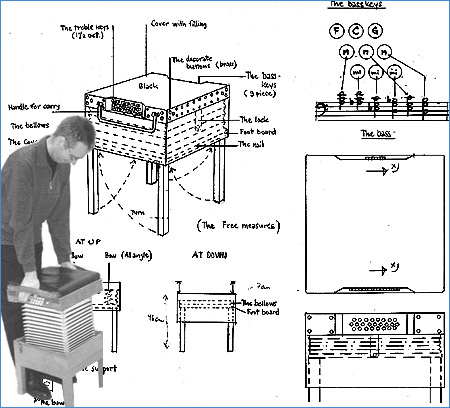 |
|
 The
'accordion boot' design is also pictured here. The
'accordion boot' design is also pictured here. This design never made it to the manufacturing table, however is still a fun concept which would have fit nicely into Lasse's show routines. |
|
| What other interests and hobbies besides music do you have? | |
 He
loves sailing and spent alot of time on his 33 foot sailing boat. He
loves sailing and spent alot of time on his 33 foot sailing boat.He proudly shows the picture of his boat called "Dance of the Wind" named after one of his compositions, which is pictured to the left. |
|
| You were also instrumental in the launching of the Sata-Häme Soi Accordion Festival back in 1972 with Heikki Eränen. This festival has grown to attract some 36,000 attendees from all over the world. Did you ever imagine it would become a major international event? | |
 He
couldn't imagine it then, and he can't imagine it now! He gives much credit
to his co-founder of the festival Heikki Eränen with whom he spent
many hours on the phone planning and discussing the festival. Pictured
above and below are both outdoor and indoor capacity audiences that gather
each year to attend the festival. He
couldn't imagine it then, and he can't imagine it now! He gives much credit
to his co-founder of the festival Heikki Eränen with whom he spent
many hours on the phone planning and discussing the festival. Pictured
above and below are both outdoor and indoor capacity audiences that gather
each year to attend the festival. Kimmo
Mattila explains further: In the early 1970's Heikki Eränen twice
organized a local concert in Ikaalinen, where amateur accordionists from
Ikaalinen played. Heikki asked Lasse to come from Helsinki to play there
as well. Kimmo
Mattila explains further: In the early 1970's Heikki Eränen twice
organized a local concert in Ikaalinen, where amateur accordionists from
Ikaalinen played. Heikki asked Lasse to come from Helsinki to play there
as well. 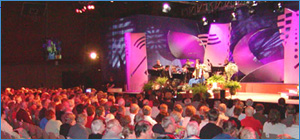 Lasse
was very busy with his business and his teaching institute but Heikki
Eränen managed to get him to Ikaalinen, because he originated from
the Jämijärvi area (close by) and had many old friends and other
people that would like to see him back in the area performing again. Lasse
was very busy with his business and his teaching institute but Heikki
Eränen managed to get him to Ikaalinen, because he originated from
the Jämijärvi area (close by) and had many old friends and other
people that would like to see him back in the area performing again.Lasse came and played in the concert with a great success, and after that Eränen and Pihlajamaa decided to found the Sata-Häme Soi Accordion Festival. The first festival was next year, in June 1972. (Heikki Eränen is now 76 years, and lives in the center of Ikaalinen.) |
|
| You are considered a true Idol for the Sata-Häme Soi Festival and have played there almost every year, and if not performing, you are often in attendance. The festival opens with a dedication at your monument in Jämijärvi. Can you tell us about this Statue? | |
|
|
|
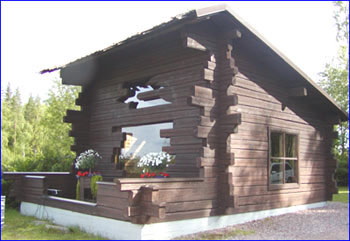 |
|
|
The monument
to Lasse's mother, located near Jämijärvi
|
|
| What do you regard as your greatest achievement? | |
|
|
|
| What advice do you have for aspiring accordionists? | |
| His
says his advice is like that of a father to his children, just the simple
old fashioned advice... work and practice! |
|
|
|
|

 The
works of Lasse Pihlajamaa fall into several genres including: virtuoso
pieces, character pieces, 'utility' music (waltzes, schottisches, tangos,
etc.), teaching pieces and electronic experiments. It must be added
here that almost all his compositions are of a markedly instrumental
nature; so much so that even the traditional waltzes in minor keys bear
some special accordionist trait. Many of the utility pieces likewise
require a phenomenal technique. Pihlajamaa composed virtually no pure
pop or 'Schlager' music at all.
The
works of Lasse Pihlajamaa fall into several genres including: virtuoso
pieces, character pieces, 'utility' music (waltzes, schottisches, tangos,
etc.), teaching pieces and electronic experiments. It must be added
here that almost all his compositions are of a markedly instrumental
nature; so much so that even the traditional waltzes in minor keys bear
some special accordionist trait. Many of the utility pieces likewise
require a phenomenal technique. Pihlajamaa composed virtually no pure
pop or 'Schlager' music at all.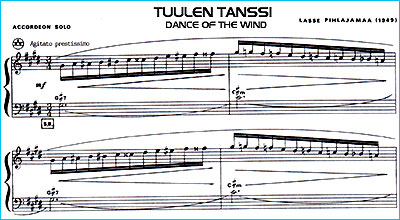 The
best-known of all the virtuoso pieces by Lasse Pihlajamaa is undoubtedly
Tuulen Tanssi, written during a tour of Lapland in early spring 1949.
An eddy of snow rising from the valley while he was out skiing was immediately
transformed in his mind into the scherzando section of the piece. This
'dance of the wind' is a waltz scherzo in variation form, its main motif
the three-note G#-A-C#1; around it whirl chromatic prestissimo flurries,
virtuoso runs and bellows tremolos. Tuulen Tanssi is in every respect
a consistent entity that surely deserves the most classical status in
its composer's entire output.
The
best-known of all the virtuoso pieces by Lasse Pihlajamaa is undoubtedly
Tuulen Tanssi, written during a tour of Lapland in early spring 1949.
An eddy of snow rising from the valley while he was out skiing was immediately
transformed in his mind into the scherzando section of the piece. This
'dance of the wind' is a waltz scherzo in variation form, its main motif
the three-note G#-A-C#1; around it whirl chromatic prestissimo flurries,
virtuoso runs and bellows tremolos. Tuulen Tanssi is in every respect
a consistent entity that surely deserves the most classical status in
its composer's entire output. Towards
the end of the 1960s Lasse Pihlajamaa began to compose for free-bass
accordion. While touring North America he wrote Muunnelmia Mollissa
(1968), a set of variations in the minor that is really his only attempt
at more absolute music. It clearly proves that he can, if he wishes,
handle the established structural principles of music, even down to
motif technique. He also did an arrangement of Sudenkorento for free-bass
accordion. This is, however, so difficult to play that it has of necessity
had to be simplified. A charming mood piece is the humoresque Ponin
Rattailla (1969) in which the pony trots along with its cart to jazzy
harmonies and rhythms.
Towards
the end of the 1960s Lasse Pihlajamaa began to compose for free-bass
accordion. While touring North America he wrote Muunnelmia Mollissa
(1968), a set of variations in the minor that is really his only attempt
at more absolute music. It clearly proves that he can, if he wishes,
handle the established structural principles of music, even down to
motif technique. He also did an arrangement of Sudenkorento for free-bass
accordion. This is, however, so difficult to play that it has of necessity
had to be simplified. A charming mood piece is the humoresque Ponin
Rattailla (1969) in which the pony trots along with its cart to jazzy
harmonies and rhythms.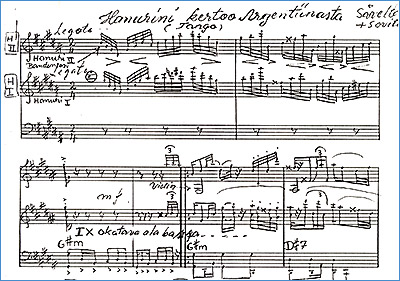 Tangos:
It seems strange in a way that of all the accordionists of the 1930s
and 40s, Lasse Pihlajamaa was the only one to show any true interest
in the Argentinean tango. Others must undoubtedly have heard the bandoneon
on record and in the live performances of visiting orchestras, but Pihlajamaa
was the only composer whose music and style directly reflected the new
sound. There is hardly a trace of the four-square approach and melancholy
melodies of the standard Finnish tango in Hanuriini Kertoo Argentiinasta
(echoes of Argentina), Auringon Nousessa (sunrise), Revontulten Alla
(the Northern Lights) or in the arrangement Pikku Ystävä (about
a little friend). The rhythms are varied, the melodies truly impressionistic
and the harmonies rich. The imitation of the bandoneon rhythms produced
a new combination of bellows and finger articulation so that the accordion
most often approached the extremes of sustained sound and incisiveness.
Tangos:
It seems strange in a way that of all the accordionists of the 1930s
and 40s, Lasse Pihlajamaa was the only one to show any true interest
in the Argentinean tango. Others must undoubtedly have heard the bandoneon
on record and in the live performances of visiting orchestras, but Pihlajamaa
was the only composer whose music and style directly reflected the new
sound. There is hardly a trace of the four-square approach and melancholy
melodies of the standard Finnish tango in Hanuriini Kertoo Argentiinasta
(echoes of Argentina), Auringon Nousessa (sunrise), Revontulten Alla
(the Northern Lights) or in the arrangement Pikku Ystävä (about
a little friend). The rhythms are varied, the melodies truly impressionistic
and the harmonies rich. The imitation of the bandoneon rhythms produced
a new combination of bellows and finger articulation so that the accordion
most often approached the extremes of sustained sound and incisiveness. Jämijärven
Jenkka (a schottische) would long ago no doubt have become the most
popular Finnish accordion schottische were it not so difficult for the
average accordionist to play. Despite its lusty folksy element, it is,
along with Vipinäjenkka and Lysti Lauantai also composed in the
1970s, the work of a virtuoso for other virtuosos.
Jämijärven
Jenkka (a schottische) would long ago no doubt have become the most
popular Finnish accordion schottische were it not so difficult for the
average accordionist to play. Despite its lusty folksy element, it is,
along with Vipinäjenkka and Lysti Lauantai also composed in the
1970s, the work of a virtuoso for other virtuosos. He
was at the founding meeting of the Finnish Accordion Association in
1952.
He
was at the founding meeting of the Finnish Accordion Association in
1952.  When
they started teaching there were no small children's models. At the
time, here was just one accordion factory in Finland, located in Kouvola.
This factory had just a full size instrument, so Lasse went to Italy
to help develop a child's model.
When
they started teaching there were no small children's models. At the
time, here was just one accordion factory in Finland, located in Kouvola.
This factory had just a full size instrument, so Lasse went to Italy
to help develop a child's model.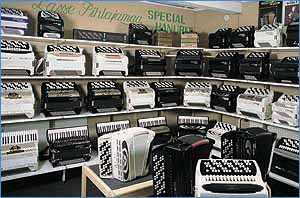 During
his visit to Italy, he remembers some humorous stories as he came across
many interesting personalities. He visited approximately 10 factories
as he was checking out different places that specialized in producing
different parts of the accordion. At one such factory Lasse was asked
to test an instrument which was supposed to be some kind of free bass
accordion. Unimpressed, Lasse told them that he thought it was basically
junk, and Lasse laughs as he recalls being told by the factory owner
that he was worse than a Sicilian!
During
his visit to Italy, he remembers some humorous stories as he came across
many interesting personalities. He visited approximately 10 factories
as he was checking out different places that specialized in producing
different parts of the accordion. At one such factory Lasse was asked
to test an instrument which was supposed to be some kind of free bass
accordion. Unimpressed, Lasse told them that he thought it was basically
junk, and Lasse laughs as he recalls being told by the factory owner
that he was worse than a Sicilian! He
sold his accordion company 'Lasse Pihlajamaa Oy' some years ago, however
it is still operated today and is located in Seinäjoki, Finland,
some 330 km north of Helsinki.
He
sold his accordion company 'Lasse Pihlajamaa Oy' some years ago, however
it is still operated today and is located in Seinäjoki, Finland,
some 330 km north of Helsinki. 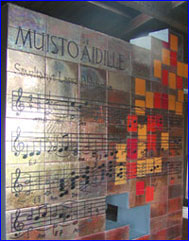 He
had experienced such a difficult upbringing with his family and his
mother due to poverty and the horrible suffering and sometimes devastating
experiences endured from bands of roaming criminals who routinely terrorized
single widows and their families, that he supposes the wild west must
have been so much better than what he and his family, in particular
his mother, had experienced.
He
had experienced such a difficult upbringing with his family and his
mother due to poverty and the horrible suffering and sometimes devastating
experiences endured from bands of roaming criminals who routinely terrorized
single widows and their families, that he supposes the wild west must
have been so much better than what he and his family, in particular
his mother, had experienced.  He
had already decided the ideas for the statue for his mother, including
its design and what words would be written, many years ago, in fact
some 30 years before the actual realization of the statue!
He
had already decided the ideas for the statue for his mother, including
its design and what words would be written, many years ago, in fact
some 30 years before the actual realization of the statue!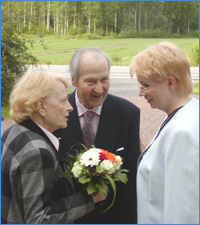 Last
year he donated the piece of land with the monument to the city of Jämijärvi.
The statue receives many visitors during the year and of course during
the opening of the annual Sata-Häme Soi Festival,
so this also helps in that the city of Jämijärvi can assist
with the upkeep of the monument and surrounding land.
Last
year he donated the piece of land with the monument to the city of Jämijärvi.
The statue receives many visitors during the year and of course during
the opening of the annual Sata-Häme Soi Festival,
so this also helps in that the city of Jämijärvi can assist
with the upkeep of the monument and surrounding land.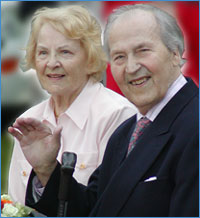 Lasse
proudly states that the greatest achievement of Lasse Pihlajamaa was
that he won in the lottery of life... the jackpot.. his wife Maire!
Lasse
proudly states that the greatest achievement of Lasse Pihlajamaa was
that he won in the lottery of life... the jackpot.. his wife Maire!